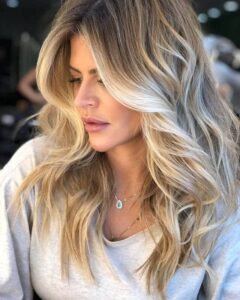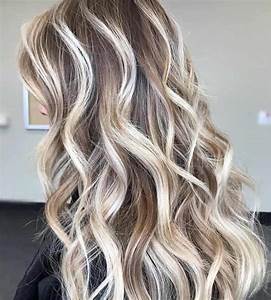What is balayage? Everything you need to know about the hair color trend


Want to recreate those natural highlights you had as a kid? Balayage can do that. Balayage makes you look like you just returned From a lavish summer vacation. Balayage says, “I have great hair” in a way that’s subtle yet noticeable — not flashy and obvious. Here’s everything you need to know about the trend.
Wait, what does “balayage” mean?
The term comes from the French word “balayer,” meaning to sweep. It’s a term that refers to the way the color is applied, not the Color itself. “Balayage is a technique where hair color is painted onto the hair to create a graduated, more natural-looking Highlight effect,” says Warren.
That means the final look is less stripy than highlights of the past, while offering the same gorgeous dimension and fun color. These hand-painted highlights “allow for pops of brightness and contrast throughout the hair, while still keeping it looking Natural,

Why is balayage so popular?
•It requires less maintenance than most hair color. Since the process is designed to give the look of grown-out roots in a Way that’s flattering and natural instead of stark and skunky, it’s less work to maintain. That translates to less time and money Spent at the salon, and in turn, less damage done to the hair. “I have some clients who go 6-8 months between visits,” says Giovanni, while others opt to come in every 6-10 weeks.
•It’s customized. Every balayage is different: Placement, gradation, and color is based on your hair color, texture, and length, So it “can be personalized for each client to highlight or soften facial features,” says giovanni. “A good stylist will always take into Consideration the [client’s] skin tone and natural base color to determine which tones will work best,” says giovanni sabrano, Artistic director No two balayages should look the same — keep that in mind as you’re looking through your stylist’s portfolio.
“Many forms of balayage are not patterns a stylist follows,” says giovanni sabrano, a colorist at corona del mar ca. “We look at The hair as a whole and find the pieces that would accentuate certain features or a specific haircut. My clients love it because it’s More tailored to them.”
How is balayage achieved?
First, your stylist should ask you some curated questions to learn what you’re looking for. “You have to have the end look in Mind to know where to start,” says giovanni sabrano says some good questions to expect from your stylist are:
- What is your favorite (and least favorite) part of your hair?
- How do you style your hair on a daily basis?
- How often are you looking to get your balayage touched up?
These FAQs allow your stylist to contour and highlight your color based on your lifestyle and preferred features to create an end Look that’s curated just for you. Then, your stylist will paint sections of your hair with bleach. The strokes should be light-handed Toward the root of the hair, and more saturated toward the ends of the hair to mimic the way that hair naturally lightens in the Sun. That gradual placement also prevents obvious grow-out, allowing you to go longer between appointments.
A good balayage is all about placement and blending. Having contrast between the light and dark tones is what creates natural Looking, lived-in dimension,” says giovanni. “A good balayage blends seamlessly from dark hues to the lightest, leaving the color Looking soft with no harsh lines.”
How is balayage different from highlights or ombre?
The terms “balayage,” “ombre,” “babylights,” and “highlights” are all various styles and techniques that refer to the same goal: Lightening the hair. They can all be combined for a desired look. In fact, giovanni says that the most common inspiration photo She sees is “a combination of babylights with balayage and ombre.” Let us decode for you:
•Traditional highlights are created by sectioning pieces of hair and wrapping in foil from root to tip. “Foil highlights are Placed close to the scalp, keeping the lightener from getting on the surrounding hair,” says giovanni. Bright, noticeable lines of Color will be woven throughout the hair as result. Wrapping hair in foil allows the color to develop more quickly (a.k.a. lighten More) than it might with just hand-painting, which is why many stylists still use some strategically-placed foils, even when Balayaging.
•Babylights are super-thin highlights that mimic the look of a child’s natural highlights (hence the name). “A babylight consists Of an extremely small, thin section of hair, creating a super subtle, sun-kissed result,” says giovanni, thanks to the much-smaller Weave used. Babylights can be used “to finely break up the root color for best grow-out results,” says giovanni.

•Ombre means “shaded from dark to light,” so balayage is actually a technique used to create ombre, explains Warren. However, if you ask for an ombre at the salon, chances are that all of your ends will be lightened, and the color will start lower on The hair shaft.
The ends of the hair get a lot lighter with ombre than they might with balayage, since the entire strand is saturated with bleach For a “more solid finish,” says giovanni. With balayage, strands are sparingly painted, and those that are dyed blend up higher Into the hair.
•Balayage offers lightness with a softer, more blended appearance. The technique mimics what might happen to your hair if it Were to lighten naturally with the sun, and there’s “no line of demarcation … striping, or harsh lines of color,” says giovanni. Balayage typically maintains the root color and eliminates any telltale lines of color, allowing you to go longer between Appointments since it looks “lived-in” off the bat.

